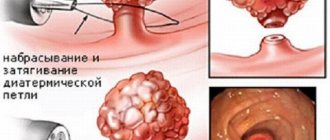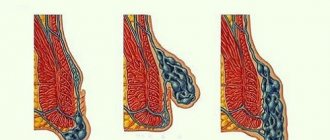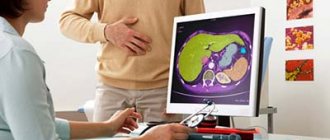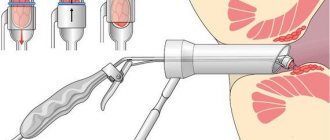Cancer is an oncological disease that often leads to death. Rectal cancer is no exception. Hemorrhoids, in turn, although an unpleasant disease, are still not fatal. Unfortunately, colon cancer is often hidden under the symptoms of hemorrhoids. Therefore, it is important for patients to know how to distinguish hemorrhoids from rectal cancer.
Rectal cancer is an oncological disease that is often fatal.
Hemorrhoids and cancer: How to distinguish in the early stages of pathology?
Patients often wonder if ✅HEMORRHOIDS can turn into CANCER? Hemorrhoids do not always turn into cancer and do not even always cause complications. Moreover, it is not uncommon for it to go away on its own or go into a passive stage and not bother a person for many years. But this is only in cases where the patient is attentive to his health, does not overwork, does not suffer from constipation and does not drink alcohol. If these conditions are neglected, the pathology requires treatment, otherwise complications are guaranteed.
Hemorrhoids and rectal cancer are very similar. They have common symptoms, but there are also differences that make it possible to distinguish one disease from another.
The danger of hemorrhoids
Patients often wonder whether hemorrhoids can turn into cancer? Hemorrhoids do not always turn into cancer and do not even always cause complications. Moreover, it is not uncommon for it to go away on its own or go into a passive stage and not bother a person for many years. But this is only in cases where the patient is attentive to his health, does not overwork, does not suffer from constipation and does not drink alcohol. If these conditions are neglected, the pathology requires treatment, otherwise complications are guaranteed.
Hemorrhoids are a disease that gets worse every time. It subsides for a while, and then arises with renewed vigor. First, one painful node appears. And during this period the patient feels the worst. Then the person gets used to the pain and the appearance of new nodes is a little easier to bear. Over time, there may be so many nodes that they surround the anus on all sides. It becomes difficult for the patient to perform the act of defecation and carry out hygienic measures.
And if no measures are taken, various complications may arise. Excessive bleeding causes a decrease in hemoglobin and anemia. Thrombosis and purulent formations may occur at the sites of nodes. Hemorrhoids contribute to rectal prolapse, swelling and cracks. It can also develop into cancer over time.
The doctor pays attention to the nature of pain and the general condition of the patient
Hemorrhoids and cancer: symptoms, diagnosis and prevention
- General information about pathology
- Symptoms and distinctive signs of pathologies
- The danger of hemorrhoids
- Differential diagnosis
- Preventive measures
It is very important to make a diagnosis at the first signs of pathology; the patient’s life may depend on it.
General information about pathology
To understand how hemorrhoids may differ from rectal cancer, you need to have an understanding of both diseases and know their symptoms.
What are hemorrhoids
This disease is known to many, but they prefer not to talk about it out loud. Hemorrhoids are varicose veins that are located in the rectal area. The pathology occurs in the anus, which is why people are embarrassed to talk about it. This is also the reason why patients are in no hurry to see a doctor and often end up in the clinic when the disease is already advanced, and it is quite difficult to treat.
The risk group of people who are more likely to suffer from hemorrhoids includes:
1. Most often, the pathology occurs in people whose activities involve sitting still for long periods of time. For example, people sitting at a computer or long-haul drivers. Standing in one place for a long period of time also contributes to the development of the disease. All this is due to the fact that this type of activity causes congestion in the pelvic area, blood flow decreases, and pressure in the veins increases, so hemorrhoidal cones are formed.
2. Also, people with heavy physical activity often suffer from hemorrhoids, for example, builders and athletes who carry heavy loads. In this case, during exercise, pressure occurs in the abdominal area, which is transmitted to the rectum. As a result, hemorrhoids form and hemorrhoids occur, which over time can develop into cancer.
3. Pathology often occurs in women during pregnancy or during childbirth. In the first case - due to stagnation in the pelvis due to fetal pressure on the internal organs, in the second - due to incorrect pushing.
4. People with chronic and acute constipation are also at risk of having hemorrhoids.
Pathology can be internal or external . The disease begins with acute itching in the anus. But severe pain and enlargement of the node may immediately occur. When visiting the toilet, blood appears on paper and in the stool. Over time, the disease progresses and new bumps may appear. The disease is also fraught with complications.
If the patient seeks help at the initial stage of the disease, you can get by with the use of special medications. In advanced forms, surgical intervention may be required.
Characteristics of rectal cancer
The human rectum can suffer not only from hemorrhoids, but also from cancer. This pathology is very dangerous and, if untreated, leads to death in 99% of cases. With treatment, the patient's life can last up to five years, but only if treatment is started at the initial stage of the disease.
The symptoms of the disease depend on the area of the large intestine in which the tumor is located. If cancer begins to develop in the deep parts of the intestine, the nature of bowel movements does not change, so the patient does not experience anxiety when going to the toilet. Suspicions may arise when anemia resulting from internal bleeding is detected. When bleeding becomes heavy, the color of the stool changes. It becomes dark and mixed with blood. With hemorrhoids, stool does not mix with blood; it may be on top of the stool.
If cancer develops in the final part of the rectum, it is easier to detect. The tumor begins to grow and block the anus. As a result, it becomes difficult for the patient to defecate. He experiences constipation, which alternates with diarrhea. Often he cannot empty the intestines completely, due to the fact that the stool comes out in the form of a thin pencil-shaped stool. In this case, blood is clearly visible in the stool. It is bright red, like hemorrhoids. A tumor in the rectum makes it difficult for the patient to defecate
Symptoms and distinctive signs of pathologies
The difference between hemorrhoids and rectal cancer lies in the external manifestation of the diseases and their symptoms. You should also take into account some factors that are characteristic of only one of the pathologies, or more often accompany it:
Hemorrhoids and cancer: briefly about these diseases
Hemorrhoids are, in fact, varicose veins of the rectum, which arises due to the negative impact of a number of factors.
The main pathogenetic factor for hemorrhoids is the formation of stagnation in the venous vessels of the small pelvis. Venous vessels fill with blood and expand under its volume, thus forming hemorrhoidal pockets (nodes, lumps).
The second most important pathogenetic and at the same time etiological factor of hemorrhoids can be called a disruption of the intestines, that is, diarrhea or constipation (when a person pushes as hard as he can). These factors lead to increased pressure inside the abdominal cavity and, accordingly, to hemorrhoids.
The definitive cause of hemorrhoids has not been established, but there are a number of factors that contribute to it. A sedentary lifestyle, sedentary work, bad habits, unhealthy diet, pregnancy, natural childbirth, heredity - all this can lead to the appearance of hemorrhoidal cones.
Mostly young and middle-aged people suffer from hemorrhoids, and men are twice as likely to suffer from women.
Rectal cancer is a malignant neoplasm that grows from the epithelium of the rectum. A tumor in the rectal canal can grow either into its lumen or invade its walls.
Rectal cancer is promoted by such factors as the predominance of meat products in the daily diet, inflammatory processes of the digestive tract, intestinal polyposis, papillomaviruses, and prolonged contact with asbestos.
Rectal cancer is characterized by slow growth and progression. It will take 18-24 months for the tumor to begin to protrude into the rectal canal; after the same amount of time, metastases may appear in the lymph nodes, lungs, liver and other organs and tissues.
Men over 50 years of age are more likely to suffer from rectal cancer.
How to distinguish hemorrhoids from colon cancer
Glad to see you on the Human Body channel! There have been very few likes lately and it's a shame
for our team! We hope for your support in the form of likes and subscriptions to the channel!
Today we will talk about the differences between colon cancer and hemorrhoids.
Typical symptoms of hemorrhoids are pain and burning around the anus. Patients often experience rectal bleeding, traces of blood in stool or toilet paper. The disease, although painful, is usually harmless.
The situation is different in the case of colon cancer. Here the prognosis is very serious and immediate treatment is necessary. What are the symptoms of colon cancer? How to distinguish hemorrhoid cancer from colon cancer?
Colon Cancer Symptoms
Symptoms associated with colon cancer depend on the location of the cancer. A tumor located in the initial part of the colon usually does not cause problems associated with bowel movements in the initial stages. In the case of this type of cancer, the first symptom is usually symptoms of anemia caused by chronic bleeding from the tumor.
There will be traces of blood in the stool. The stool becomes darker and comes out mixed with stool, unlike the blood of hemorrhoids. With hemorrhoids, blood often occurs in the form of bloody spots covering the stool.
Terminal colon cancer is a little different. This type of colon cancer usually grows in a concentrated manner, meaning it expands and reduces the lumen of the intestine. Patients complain of changes in the nature of bowel movements. They may experience alternating constipation and diarrhea.
The shape of the chair also changes. It becomes long and thin (about like a pencil). In this case, there is also blood in the stool, which is bright red and looks like blood from hemorrhoids.
What should you be concerned about?
Alarming symptoms that should prompt you to see a doctor are the aforementioned changes in bowel habits, changes in the shape of stool, fairly heavy bleeding from the anus, abdominal pain, symptoms of anemia and weight loss. Hemorrhoids can be detected by rectal or proctoscopy examination. However, to rule out colon cancer, it is necessary to conduct a complete examination of the colon - a colonoscopy.
Hemorrhoids and colon cancer can exist at the same time!
It should be remembered that both diseases, that is, hemorrhoids and colon cancer, can coexist and their symptoms may overlap. Therefore, if you notice something alarming, you should contact your doctor for a thorough diagnosis. People who have had cancer in their family should be especially vigilant. This is where I will end the article. Dear Reader
, please like and subscribe to the channel!
You only have to press two buttons, but that means a lot to me!
Symptoms and distinctive signs of pathologies
The difference between hemorrhoids and rectal cancer lies in the external manifestation of the diseases and their symptoms. You should also take into account some factors that are characteristic of only one of the pathologies, or more often accompany it:
- For example, colorectal cancer is more common in people over 50 years of age. Heredity also plays a role in the occurrence of the disease.
- The location of cancer and hemorrhoids can be different. For example, hemorrhoids never form deeper than 3 cm from the anus. While cancer can form at the very beginning of the rectum.
- The type of hemorrhoidal cones and neoplasms also differs. The tumors are dense and located in one place. Hemorrhoid nodes are elastic and mobile upon palpation.
- Discharge from cancer can be not only in the form of blood, but also mucous. They occur even at rest, without defecation. Moreover, more mucus is released than blood. With hemorrhoids, there is no mucus.
- Cancer stool is dark, mixed with blood. With hemorrhoids, the stool is clean, without mucus and blood. Blood is released at the end of a bowel movement and is found on toilet paper and on top of stool.
- With cancer, weight loss is almost always observed. With hemorrhoids, the weight may remain in place. A person can only lose weight if he begins to eat less food, fearing that he will have to go to the toilet and endure pain during bowel movements.
- Anemia can be observed in both cases, but with cancer it is more pronounced and occurs more abruptly due to blood loss.
- The nature of the pain is also different. With cancer, the pain may be in the lower abdomen and radiate to the lower back. With hemorrhoids, pain and burning are observed in the anus and radiate to the rectum.
How else do hemorrhoids differ from cancer? This is a common condition. Hemorrhoids do not affect your general well-being in any way. Pain and discomfort disappear a few minutes after defecation, and then the patient can calmly go about his business, forgetting about the sore. This, by the way, is often the reason why patients do not sound the alarm and do not go to the doctor.
With cancer, the patient loses strength and gets tired quickly. His taste changes, and many dishes that he used to love become tasteless to him.
Anatomical structure of the large intestine
Cancer or hemorrhoids: a detailed analysis of the differences between diseases
The number of people faced with the problem of diagnosing hemorrhoids or cancer is inevitably growing. The issue is delicate and very personal; patients are often embarrassed to see a doctor, which makes early diagnosis of both of these diseases difficult. Both hemorrhoids and cancer are insidious diseases that begin with virtually no symptoms, but both, although hemorrhoids are much less common, can result in death for the patient. Therefore, it is so important to visit a doctor not only when symptoms of the disease begin, but also for preventive purposes, but not to engage in self-diagnosis. Only a specialist knows how to distinguish hemorrhoids from rectal cancer
What to do if such symptoms appear?
Only a doctor can understand what kind of disease a person is developing, hemorrhoids or cancer. To make an accurate diagnosis, it is necessary to conduct a laboratory test of urine and feces for occult blood and determine the level of hemoglobin.
It is also mandatory to donate blood for tumor markers. If the analysis shows an increase in the concentration of biological compounds indicating inflammatory processes and cell degeneration, further examination is prescribed, which includes colonoscopy and CT.
Colonoscopy is the most effective method for diagnosing cancer of the rectum and the entire intestine in general.
Comparative characteristics of the causes of diseases
Varicose nodes formed as a result of thickening of the walls of venous vessels are called hemorrhoids. The process occurs in the mucous membrane of the rectum, accompanied by discomfort in defecation, constipation and minor bleeding. This disease has no age restrictions, although it is most often observed in men 35-45 years old. Factors that can provoke the disease:
- Sedentary work mode, reduced physical activity.
- Poor nutrition, which results in constipation.
- Hereditary predisposition.
- Physical activity - sports, work associated with lifting weights, when the pelvic floor is often under tension. Pregnancy can be included in this category of causes for the development of hemorrhoids. The growing uterus compresses the pelvic veins, in which “stagnant” areas are formed - the blood flow in these vessels is sharply disrupted. It is in them that the vein stretches, thus forming hemorrhoidal cones.
Cancer is a pathological process of the rectum with the formation of atypical cells of epithelial origin. Just like hemorrhoids, it inflicts its main blow on male patients, although the age group is clearly older - 50 years and above. Rectal cancer becomes malignant over time. Without special treatment, the process progresses rapidly, often with fatal outcome. Many scientists around the world have been struggling for years over the causes of rectal cancer, as well as other organs and tissues, but it is still difficult to definitively establish the etiology of this problem. Just some of the provoking factors are mentioned:
- Nonspecific inflammation of the epithelial cells of the anus - proctitis.
- Anal fissures.
- Constipation associated with eating disorders.
- Excess weight.
- Lack of physical activity.
- Working with carcinogenic substances.
- Intestinal polyposis.
Clinical manifestations of hemorrhoids
The symptoms of the disease in the initial stages can be called twin - both rectal cancer and hemorrhoids begin with discomfort in the anus and disturbances during the act of defecation (it is accompanied by pain, itching, and as the disease progresses, blood in the stool joins the listed symptoms).
It is possible to differentiate cancer and hemorrhoids from each other at such an early stage only in a hospital setting, using tests of venous blood for the presence of tumor markers in it and studying images of the pelvic organs.
At later stages of the development of the disease, hemorrhoids experience prolapse of nodes from the anal ring outward. Hemorrhoidal formations are accompanied by bleeding, which in chronic hemorrhoids can cause a low level of hemoglobin in the blood, and, as a result, anemia.
Symptoms of diseases
In the initial stages, the symptoms of hemorrhoids and cancer are very similar. In the early stages, they may cause normal discomfort. As the disease progresses, symptoms worsen. Both diseases have 4 stages of development. Stages and symptoms are indicated in the table:
| Stage | Haemorrhoids | Rectal cancer |
| 1 |
|
|
| 2 |
|
|
| 3 |
|
|
| 4 |
|
|
The color of the blood during hemorrhoidal bleeding is scarlet and is not coagulated. Cancer bleeding is darker in color and comes out in clots. This is due to the fact that the affected area is located higher in the intestine, and the further the tumor is located, the darker the blood. Coming out with the feces, the blood comes out in clots because it has time to clot.
Clinical manifestations of rectal cancer
In rectal oncology, the clinical picture is more pronounced - due to the fact that the growing tumor closes the lumen of the rectal ampulla, the excreted feces come out in the form of a thin straw - the larger the formation, the thinner it is. Such “stagnation” in the terminal part of the large intestine inevitably leads to general reactions of the body - bloating due to gases retained in the intestines, distension, pain and even vomiting. As with hemorrhoids, blood clots may be present in the stool, and in the later stages of decay it acquires a fetid odor and a non-standard color.
Atypical cells formed in colorectal cancer can release substances into the blood that are similar in effect to toxins. These compounds cause reactions in the body that do not occur with hemorrhoids, even in its later stages. The clinical picture is more reminiscent of the beginning of the development of a cold - fever, weakness and aches throughout the body, joint pain, nausea, drowsiness and fatigue. In addition, patients rapidly lose weight.
The course of rectal cancer can be complicated by paraneoplastic syndrome, which occurs:
- Incorrect operation of blood coagulating factors.
- Autoimmune diseases associated with disturbances in the functioning of immune factors may appear.
- An increase or, conversely, a decrease in hormones of the endocrine glands.
- Shift in electrolyte parameters in a biochemical blood test.
Preventive measures
Prevention of pathological processes in the rectum is as follows:
- To live an active lifestyle. If your occupation is sedentary or standing, take breaks during which you can move actively. If possible, perform special exercises for congestion in the pelvis. It is useful to do such exercises regularly every day.
- Do not lift weights, do not overload yourself.
- Avoid drinking large quantities of alcohol; everything should be in moderation.
- Proper nutrition is the path to health. You need to eat so that your stool is normal. Frequent constipation leads to hemorrhoids, as well as frequent bowel disorders. This is due to the fact that a person has to push often and hard.
- If signs of a pathological process appear, immediately seek the help of a specialist and undergo an examination. This could be oncology; it is important to identify it at an early stage and begin cancer treatment.
It is not difficult to distinguish hemorrhoids from cancer, but you need a specialist to do it. You should not self-diagnose and give in to unnecessary panic. This won't lead to anything good.
Cancer and hemorrhoids - what's the difference?
As mentioned above, in the first stages, both of these diseases are extremely difficult to identify without special diagnostics.
A thorough medical history helps a coloproctologist distinguish cancer from hemorrhoids. The survey is carried out taking into account age and gender. The main clues during an oncological interview with a patient are identifying colorectal cancer in the family and performing polypectomy operations - removal of polyps.
Patient complaints will help identify hemorrhoids or cancer.
- Complaints of bleeding from the anus. The nature of the bleeding will help you understand which disease it is - with hemorrhoids, the blood is a normal, scarlet color, and it is noticeable much better than with cancer, when it is more of an impurity or small clots in the stool.
- With hemorrhoids, the act of defecation usually occurs as before the disease; with rectal cancer, tumor decay products may come out before the feces - a mass with an unpleasant odor mixed with blood or pus.
- In case of rectal cancer, feces come out in the form of a ribbon; in case of hemorrhoids, feces have a normal shape.
- Constipation in rectal cancer is protracted; such phenomena are not observed in the clinical picture of hemorrhoids.
- Rectal cancer often occurs with general intoxication of the body.
- With late presentation, the pelvic organs and lower parts of the spinal column may be visible on the images.
Differential diagnosis
Differential diagnosis will help distinguish hemorrhoids from rectal cancer. It will help determine what a person is sick with and what help he needs. To do this, a certain examination is carried out, which consists of collecting an anamnesis and a thorough examination of the rectum.
The doctor pays attention to the nature of pain, the appearance of bowel movements and the general condition of the intestines. In addition to hemorrhoids, other diseases may occur in the rectum, for example, diverticulosis, andylomatosis, polyps, paraproctitis or Crohn's disease. They are also characterized by bleeding from the rectum, so it is important to exclude these pathologies during diagnosis.
How to distinguish hemorrhoids from rectal cancer using differential diagnosis? To do this, you need to compare all the observed symptoms with the known symptoms of cancer and hemorrhoids. Common to these pathologies are bleeding, pain, frequent urge to go to the toilet and a feeling that the intestines are not completely empty.
It is also important to know that hemorrhoids can occur with existing cancer and be a complication of it. Therefore, when hemorrhoidal lumps appear, the entire colon should be examined.
Are hemorrhoids a cause of cancer?
In medicine, there is a term “malignancy” - it means the degeneration of normal cells into atypical, that is, malignant. When considering the issue of malignancy of hemorrhoids into cancer, it is worth considering that this process will directly depend on timely diagnosis and correct treatment of hemorrhoids. If treatment is started on time, then degeneration is most often not observed.
Hemorrhoids outgrow due to impaired blood circulation in the venous bed of the rectum - nutrients and oxygen do not reach the tissues of the anal area in full, which leads to dysfunction of cellular immunity. At this moment, the barrier forces of the entire body are weakened, and it is easily exposed to free radicals, which is why healthy tissues transform into malignant tissues.
Also, the cause of degeneration can be prolonged constipation - due to an excess of metabolic products, the volume of which constantly accumulates. As a result, their aggressive effect triggers an inflammatory process in the tissues of the rectum, characterized not only by the degeneration of cells, but also by their death - necrosis. As a result, polyps and tumors form in the foci of inflammation, which can be either benign or malignant.
Diagnosis and treatment principles
The main diagnostic methods, in addition to interviewing and examining the patient, are colonoscopy, sigmoidoscopy, biopsy of pathological material taken from the rectum, and blood tests for oncology markers. Therapy for hemorrhoids often comes down to only conservative interventions - in the first stages of the disease, suppositories, ointments and tablets lead to the recovery of patients. Only in advanced cases is rectal surgery required. Treatment for rectal cancer consists of surgery and, if indicated, chemotherapy and radiation therapy.











